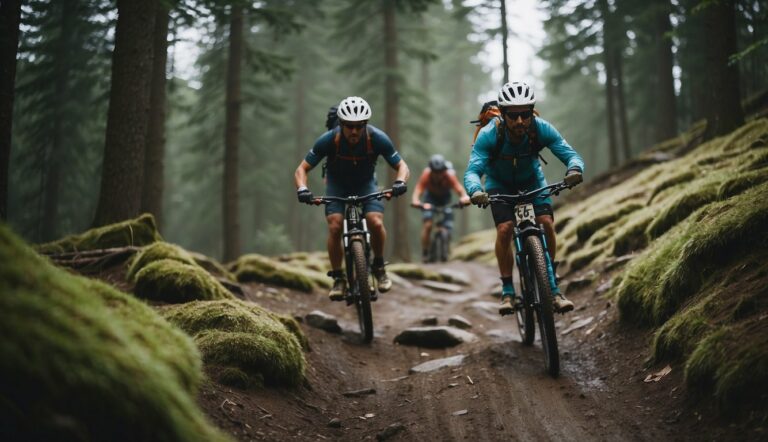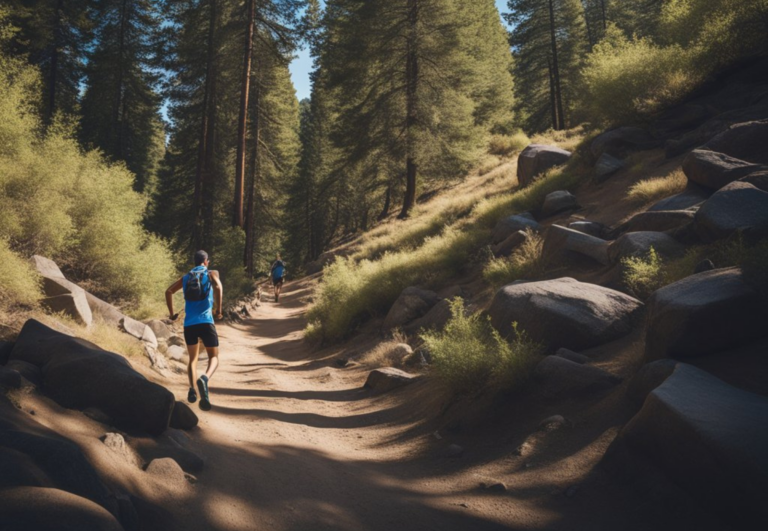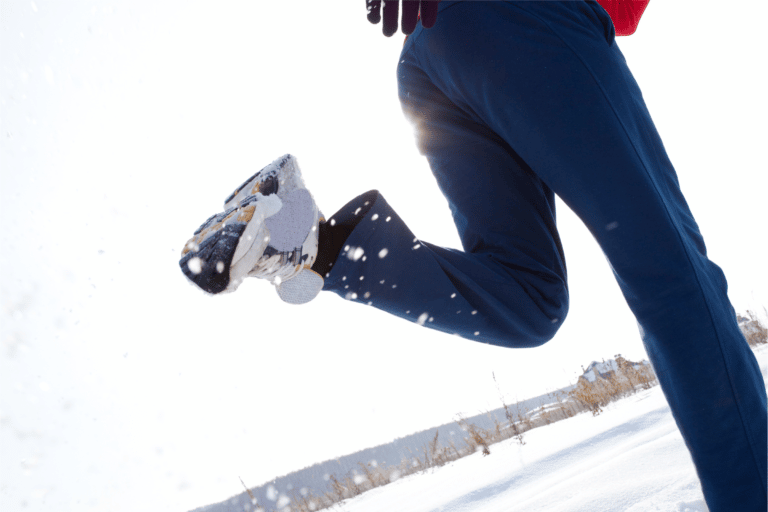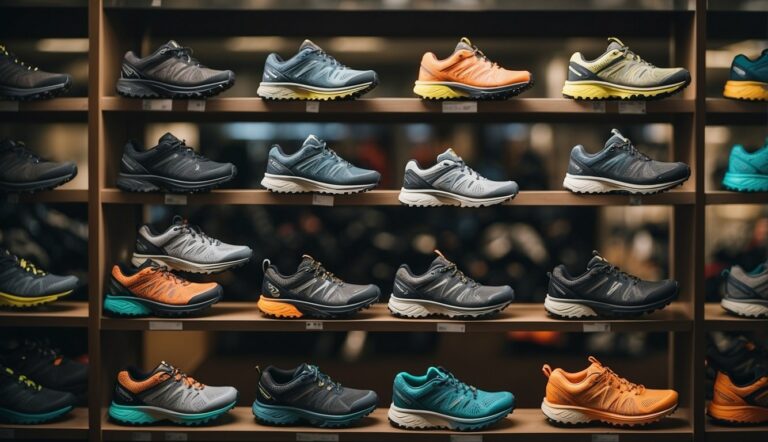How Do Weather Conditions Affect Trail Shoe Choice: Selecting the Right Footwear for the Elements
Selecting the appropriate trail shoes is vital for both performance and safety, and weather conditions are a critical factor in this choice. As a UESCA certified running coach, I’ve experienced firsthand how the right footwear can make or break your trail running experience. When it’s hot and dry, breathable and lightweight trail running shoes are preferable, keeping your feet cool and enabling better speed and comfort.
Conversely, wet and muddy conditions call for shoes with enhanced grip and waterproof features to maintain traction and keep feet dry. In snowy or icy conditions, trail shoes with a more aggressive tread or the ability to add traction devices are essential for stability. Your choice in trail shoes should adapt to these conditions to ensure your run is safe and enjoyable.
How Do Weather Conditions Affect Trail Shoe Choice? Grip, Traction, and More
In trail running, having the right shoe grip and traction can mean the difference between a successful run and an accident. It’s crucial to understand how these elements work to navigate trails safely.

Grip on Varied Terrain
When running on technical trails that may include rocks, roots, and loose dirt, the grip of your shoe becomes paramount. Deep and aggressive lugs are designed to bite into the terrain, offering stability and confidence.
The patterns and rubber compounds of the outsole should be selected based on the specific conditions of the trails you intend to run on. For dry and rocky trails, a firmer rubber outsole provides durability and a stable grip, while softer rubber compounds offer more stickiness, which is advantageous on slick rock surfaces.
Types of Lugs for Different Terrains:
- Rocky Terrain: Firmer rubber with shallower lugs for stability.
- Loose Dirt: Aggressive lugs for penetrating the surface and creating traction.
- Muddy Conditions: Deep lugs spaced widely apart to prevent mud accumulation.
Traction in Adverse Weather Conditions
For traction in adverse weather conditions, such as mud and ice, the design and material of the shoe’s outsole are crucial. Shoes designed for icy conditions often feature materials that don’t harden when temperatures drop, ensuring that the shoe maintains its traction.
Additionally, some trail shoes come equipped with built-in micro-spikes or the ability to attach crampons for enhanced grip on ice. In muddy conditions, it’s important to choose a shoe with deep lugs that are spaced far enough apart to shed the mud as you run, preventing build-up and loss of traction.
Outsole Features for Weather Conditions:
- Mud: Deep, widely spaced lugs for self-cleaning and maintaining grip.
- Ice: Specialized rubber compounds or attachments like micro-spikes for enhanced traction on slick surfaces.
Comparing Trail Shoes and Road Shoes

Choosing the right footwear can make a significant difference in your running experience, especially when accounting for varied terrain. In this section, we’ll explore the specific characteristics of trail and road shoes to help you make an informed decision.
Distinct Features of Trail Shoes
Trail shoes are designed with a focus on durability and protection. Brands like Salomon and Inov-8 are often recognized for robust offerings that cater specifically to uneven, rocky trails. One standout feature is a formidable outsole like the MaxTrac, known for its aggressive grip that adds stability when navigating through difficult terrains.
- Protection: Extra toe caps and thicker materials prevent injuries from rocks.
- Grip: Lug patterns designed to provide traction in mud, gravel, and steep inclines.
- Materials: Typically made using tougher, water-resistant fabrics like Gore-Tex, particularly observed in shoes like the Nike Pegasus Trail 4 Gore-Tex.
When to Choose Road Shoes
Road shoes are optimized for speed and comfort on hard, smooth surfaces. Their construction is lighter and they prioritize responsive cushioning to ensure a comfortable run on long stretches of road.
- Weight: Lighter than trail shoes, they help in maintaining quick pacing.
- Cushioning: Softened soles absorb impact on hard surfaces.
- Outsole: Generally flatter with less pronounced lug patterns, ideal for paved streets and sidewalks.
By understanding these specific features, you can select the right shoe that meets the demands of your running environment, whether it’s a cushioned road shoe for urban marathons or a rugged trail shoe for mountain trails.
Materials and Design for Weather Adaptability
Selecting the right trail shoes incorporates understanding how materials and design can adapt to various weather conditions. I’ll cover the crucial aspects of waterproofing and breathability, along with the role that specific materials play in weather resistance.
Waterproofing Versus Breathability
When it comes to waterproofing, Gore-Tex is a premier material found in trail shoes. It provides excellent protection against water, ensuring your feet stay dry in wet conditions. However, it’s important to balance waterproofing with breathability.
Shoes with a breathable upper are crucial for releasing moisture and heat, maintaining foot comfort, and preventing blisters, especially in warmer or more humid conditions.
- Waterproof Shoes: Ideal for wet, muddy conditions to keep feet dry.
- Breathable Shoes: Recommended for dry, warm conditions to prevent overheating.
Shoe Materials and Weather Resistance
The material of the shoe not only contributes to durability but also to how it handles the weather. A react foam midsole serves well in terms of providing responsive cushioning, which is especially beneficial on uneven trails and during temperature fluctuations.
The rock plate in the midsole adds protection against sharp objects while remaining flexible enough to navigate varied surfaces. Lastly, a sticky rubber outsole offers superior grip on both wet and dry terrain, enhancing safety and performance irrespective of weather.
- Midsole Material:
- Purpose: Cushioning (React Foam)
- Benefits: Responsive, resilient in changing temperatures
- Outsole Material:
- Purpose: Traction (Sticky Rubber)
- Benefits: Grips well in varied weather conditions
By understanding these elements, I can make informed decisions on trail shoe selection to match the weather I expect to face.
Comfort and Protection on the Trail

As a UESCA certified running coach, I know that the right trail shoes can mean the difference between an exhilarating run and an uncomfortable one. Trail running shoes should offer both comfort and protection, ensuring stability over rugged terrain and shielding your feet from the elements.
Cushioning and Stability
The cushioning in trail running shoes, like the Hoka One One Speedgoat 5, is designed to absorb shock and provide a comfortable ride on uneven trails. Here’s what you should look for:
- Midsole: A well-cushioned midsole that balances firmness and softness.
- Toe Box: Adequate room to prevent cramped toes during downhill runs.
When it comes to stability, the aim is to prevent ankle rolling without sacrificing flexibility. Look for features such as:
- Internal shoe structures that provide lateral support.
- Outsoles with a wide base and grippy lugs for traction on various surfaces.
Protection Against Trail Debris and Weather
Trail shoes must protect your feet from sharp rocks, roots, and other debris. Key elements include:
- Durable Upper: Tight-knit mesh or robust synthetic materials ward off trail debris.
- Toe Cap: Reinforced fronts reduce the impact of stubbing toes on rocks.
Weather conditions also demand protective features in a trail shoe:
- Waterproofing: Shoes with a membrane like Gore-Tex to keep your feet dry in wet conditions.
- Breathability: Ventilation that allows moisture to escape, keeping feet from overheating.
By examining these critical aspects of trail shoes, your runs and walks can be both enjoyable, regardless of weather or trail conditions.
Shoe Durability and Runner’s Needs
As an experienced UESCA certified running coach, I understand that selecting the right trail shoes is crucial for performance and comfort. Durability and the specific demands of different running events are key considerations.
Matching Shoes to Running Events
When I advise runners on shoe selection for specific events, durability is a top priority. Marathons and ultra marathons demand a shoe that can withstand long distances without breaking down.
On the other hand, events like a 5km may not stress durability as much but still require a shoe that can handle the rigors of the course. For beginners or those participating in shorter races, a comfortable, stable shoe with moderate durability is sufficient.
Remember, long distance events especially, like ultra marathons, put significant wear on shoes, so choosing one with a robust outsole and ample cushioning is vital to avoid mid-race breakdowns.
Considering Durability for Distances and Training
Durability is also crucial for training, regardless of the distances you run. Here’s a simple breakdown for different runner profiles:
- Heavy-runners: Opt for shoes with reinforced outsoles and thicker cushioning to handle increased force at each foot strike.
- Regular trainers: A balanced shoe with average durability can serve well for regular training sessions.
- Distance runners: For those frequently tackling long distances, the outsole material should be chosen based on the balance between grip and longevity.
A common misconception is that more durable shoes are always better. However, the most durable option isn’t paramount for light training or occasional runs. For those sessions, you might prioritize comfort or performance features over sheer durability.
Choosing Shoes for Different Trail Types and Conditions

When selecting trail shoes, it’s crucial to consider the specific trail type and prevailing weather conditions. The right footwear can enhance grip, provide adequate support on uneven terrain, and protect against weather-related challenges.
Shoes for Technical and Rocky Trails
On technical and rocky trails, durability and foot protection are paramount. A rugged trail shoe with reinforced toe caps and underfoot rock plates offers the best shield against sharp rocks and roots.
I recommend opting for shoes with a lower heel-to-toe drop (4-8mm) for better stability on uneven terrain. A secure fit is essential to prevent the foot from shifting inside the shoe, which could lead to twisted ankles or blisters.
- Rugged trail shoes: Enhanced durability, protection, and stability
- Heel-to-toe drop: 4-8mm for balance and stability
Adapting to Weather: Sand, Snow and Rain
For trails with loose surfaces like sand or snow, maximalist shoes with a high level of cushioning and a wider base can improve stability and provide a more comfortable ride.
In wet conditions or for trails covered in snow, I suggest water-resistant or waterproof uppers to keep feet dry and selecting a shoe with aggressive lugs for optimal traction.
- For sand: Maximalist shoes with cushioning for comfortable, stable movement
- For snow and rain: Water-resistant features with aggressive lugs for good grip
When dealing with icy conditions, additional traction devices may be necessary for safety. Remember, the correct choice in trail running shoes can make the difference between a good run and a great one, especially when faced with various trail types and weather conditions.






